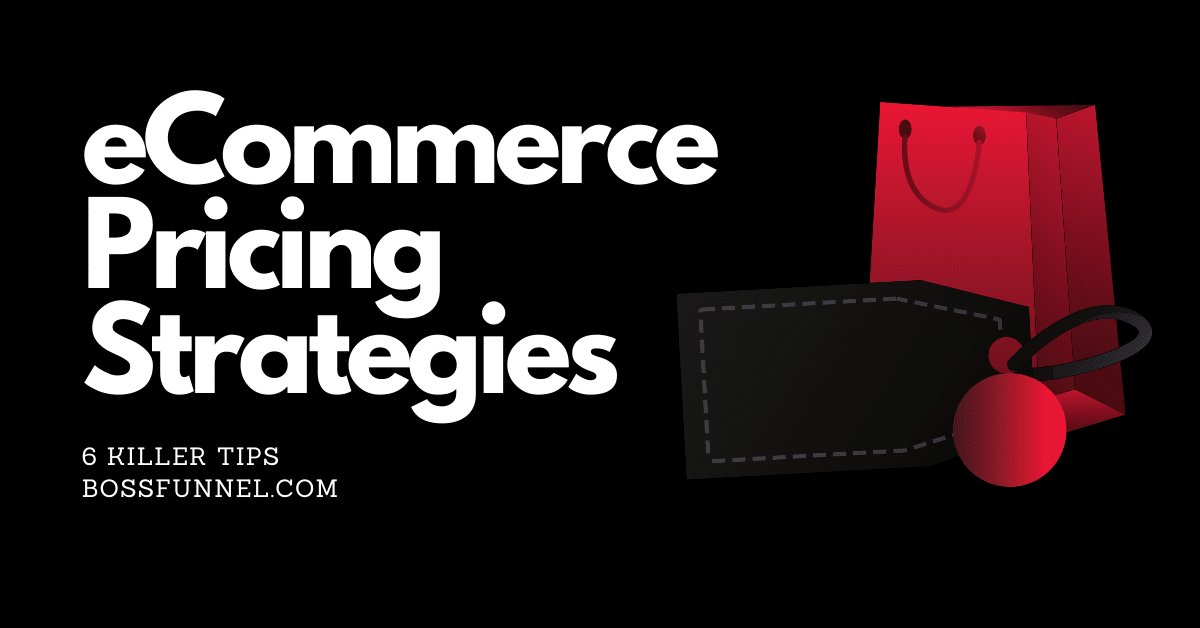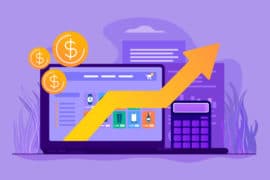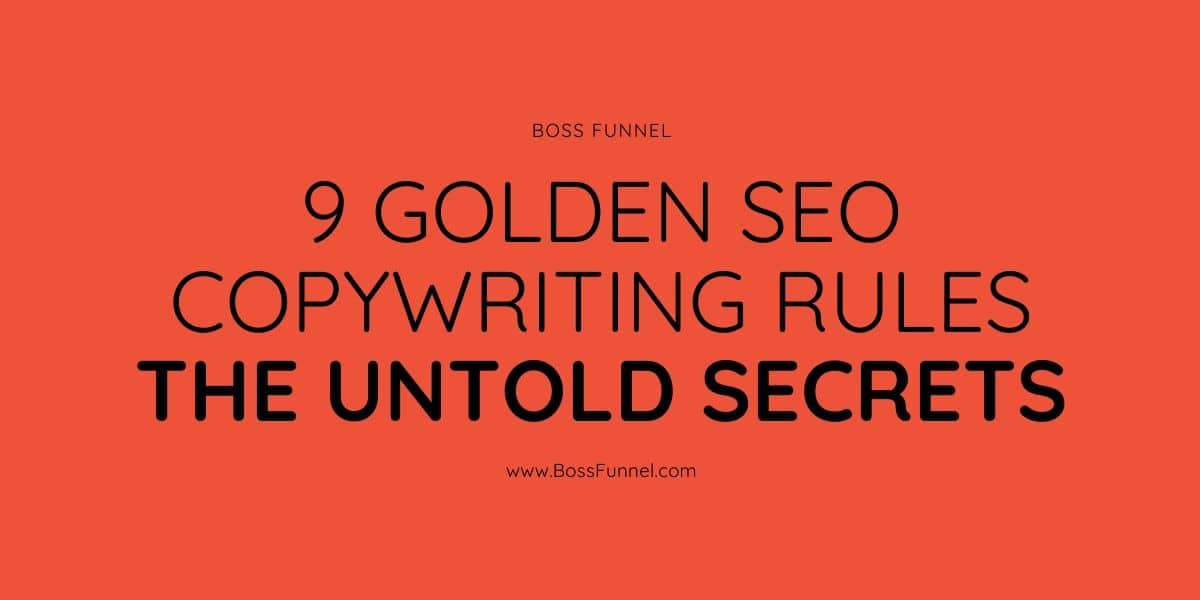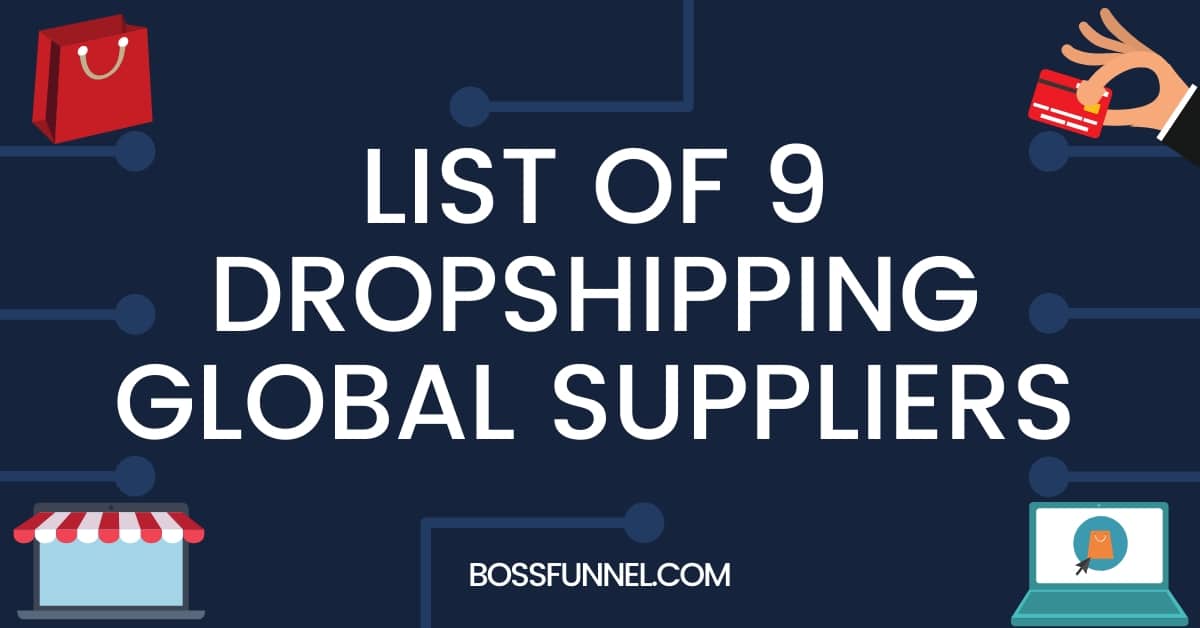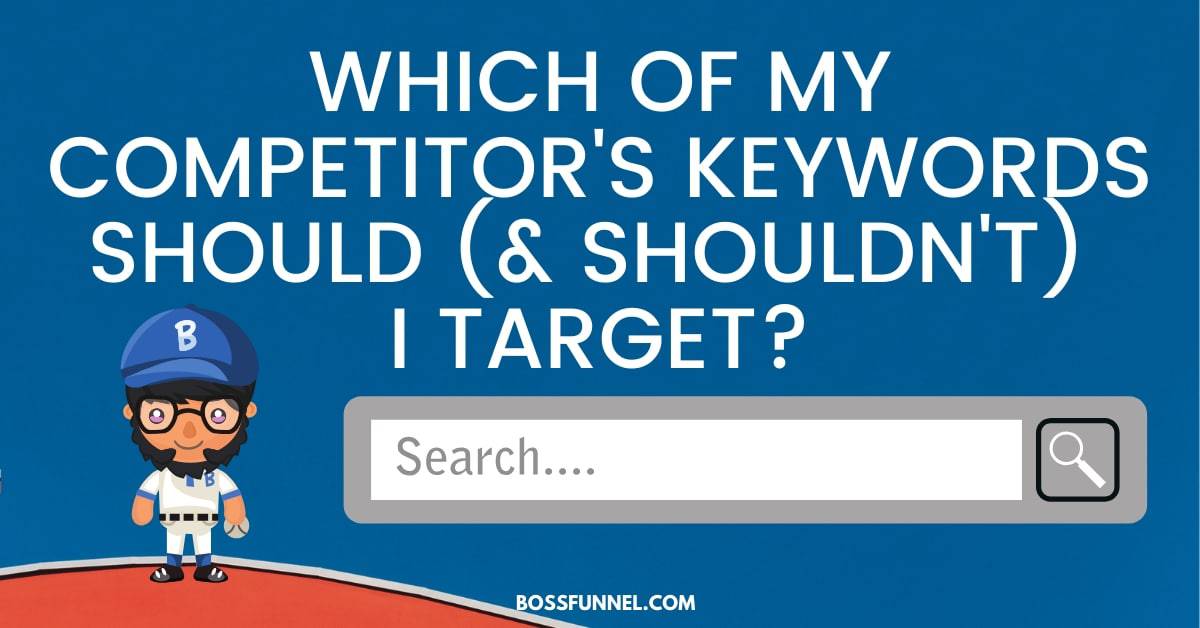Pricing is a tricky thing when it comes to an online platform, even when business pre-interviews its target group (target group) about their budget. About how much they are willing to pay for a particular product or service. In practice, their behavior is likely to differ significantly from the survey results. This state of affairs is because it is one thing to plan the expenditure of hypothetical money. It’s different to part with hard-earned real money.
We devoted a lot of articles to the topic of pricing on this blog: a simple search in the sidebar will open up an excellent overview of behavioral psychology.
How can you find the right value for your goods or tariffing services? Can you say that the prices you set mostly scare potential customers? To what extent do you need to reduce expenses focusing on competitors?
These are essential questions. The correct answers to them should be based on the pricing strategy. There should be an excellent basis for choosing the most suitable pricing strategy for an online store. They should turn pricing into an asset that allows the business owner to maximize sales.

Caption: “A sports car doesn’t always have to be expensive.”
(ad text justifying the price of $ 3,395 for the 1968 AMX convertible)
Here are a few options for pricing strategies whose application can be tested in an e-commerce organization.
1. What is the focus of USP: price or value?
Suppose the prices of products of a particular online store are the lowest in this market niche. Does this mean that such a pricing strategy should automatically be the basis of USP (unique selling proposition)? The answer “yes, it means” seems most evident in such a situation. However, not everything can be so unambiguous.
For example, one study conducted by Stanford University shows revealing facts. It states that marketing positioning based on feelings and experience can sometimes work better than focusing on a low price.
It seems that this explains the popularity of the relatively inexpensive Miller beer. The USP of which is not associated with its affordable price but sounds inviting: “Time for Miller!” (It’s Miller Time!).

Another study confirming the above assumption was related to the results of a test. The test was conducted at one of the stands advertising a particular brand of lemonade. We tested three options for marketing positioning:
- · “Spend some money enjoying C&D lemonade.”
- · “Spend some time enjoying the C&D lemonade.”
- · Enjoy C&D Lemonade (Neutral)
The results of the study showed that the application of the second option doubled the number of customers who are even willing to pay a two times higher price. Just to “ save ” time while enjoying the advertised drink. This is a vivid demonstration of how a simple pun can form in the minds of customers. It develops the subjective value of a product without reference to its low price.
The above examples are not a panacea for all cases of eCommerce life. They only show that a low price does not always sell well, although there are quite a few other cases of successful product positioning based on its low cost.
Here is one such example: the Royal Discount store. It sells computer hardware and software from brands such as Microsoft, Adobe, and others. The policy of discount prices for promoted products allows them to have a substantial competitive advantage. Therefore raising the font size denoting the discount on landing page led to a 36.54% increase in conversion.
It seems that this case can be commented as follows: for software consumers, its value is not strictly tied to the site that sells it. While a person with a Western mentality is confident that he is acquiring a licensed (legal) copy, the price level remains a determining factor for such a buyer.
2. Website optimization for a price-sensitive buyer
In the course of various studies, three classification groups of buyers were identified. It depended on the degree of cognitive activity of the brain and the level of experience of the psychological pain threshold during the purchase:
- · “Spenders” – These people did not experience any pain symptoms, parting with money;
- · “Hunks” are the opposite of the first type;
- · “Non-conflict” – people with a relatively “even” reaction, a cross between the previous two types.
Researchers from the University of Pennsylvania who interviewed more than 13 thousand people developed the “squander-miser” scale. It presented on a pie chart the percentage of participants in the above categories:

Sprains -15%; Hunks – 24%; Non-conflict – 61%
It turns out that every fourth buyer experiences certain psychological discomfort and pain. He also goes through parting with his money, even if he needs the purchased goods. The knowledge of this moment makes it necessary to optimize your offer for this category of sensitive buyers.
Given all of the above, the following intermediate conclusion can be drawn:
The pricing strategy should create conditions for the buyer in which he can spend his money with the lowest possible level of discomfort.
This means understanding that for more tolerant buyers, it will be sufficient to focus their attention on the pleasure of the purchased goods. While for more conservative ones, the practical usefulness of the offer should be given priority.
For example, here’s how to formulate a marketing message for “spender” and “non-conflict” buyers in an Audi advertising campaign:

Caption: “ All other drivers want to look into the face of your beauty RS6 … ”
“… but most of them will only see this.”

However, the following version of the advertising slogan will sound more convincing for the “skryag”:
Caption: “ You can put five times more girlfriends in this car than in Lamborghini ”
Here are some more ways to motivate a sensitive customer to make a deal.
Offer related products in a set (upsales)
It is often much easier to justify a larger purchase than a series of small ones.
Combined offer: Buy two products and get free shipping

Another option is to make the “Replenishment of stocks” option available to customers for a group of goods that they order regularly. Examples of such products include toilet paper, soap, shampoo, etc.
For such an assortment line, you can prepare a drop-down list. It should be with the ability to select the frequency and regularity of reminders about the need to update a standing order.
It remains only to indicate that the cost of the selected goods will be automatically debited from the customer’s account. It will be cut immediately before shipment that he can cancel at any time in any way convenient. He can adjust the frequency or other conditions of this order.
Your words matter
The already mentioned scientists from the University of Pennsylvania experimented with two groups of buyers (“spender” and “miser”). They used a conditional commercial offer to get a free set of DVDs at night. The conditions of the promotional offer were formulated in two versions:
- · “$ 5 is charged for shipping a free bundle.”
- · “A small fee of $ 5 is charged for shipping a free bundle.”
One word “small” increased sales conversion among a sensitive group of customers by 20%.
Get the offer in the header
For those unfamiliar with Hello Bar, we’ll clarify it. It’s a solution that activates a bright horizontal bar located at the top of the web page. It is the first to appear to the visitor every time he visits—for example, the primary or product pages of an online store. As a rule, an offer and a call to action button that is expressed in a short phrase, are placed in the header. Based on the category of buyers who are in no hurry to spend their money, you can put information about discounts and time-limited promotions in the Hello Bar.

Caption: “ Make your order in the next 3 hours and get a 35% discount! Place an Order NOW! “
For example, consider an online store that sells T-shirts for $ 100 apiece. Then selling 100 units of the specified product gives a turnover of $ 10,000. Let the cost of one T-shirt be $ 30, then your profit from the sale will be $ 7,000.
If we take into account another 30% of the discount, the store owner will have $ 40 left as profit from one T-shirt. The total benefit from 100 units of goods will be $ 4,000. Therefore to stay away from loss you need to sell not just 100 but 175 T-shirts. That will require a 75% increase in conversion. And while discounts tend to increase overall turnover, they reduce the average check size. This should be remembered in the end, not to work at a loss.
If possible, let it be free
In her book, Predictably Irrational. Dan Ariely cites an example from Amazon’s experience in the European market. The online trading giant in France attracted far fewer customers than other EU countries. It’s because, for French buyers, a delivery fee of 20 cents was introduced to cover general shipping costs and not charge a similar price in other European countries.
If this is true, then it turns out that by and large, it is not as important as how much you ask for delivery. Even if it’s only 20 cents, it is no longer free. Therefore you need to use the charming “free” instead of albeit symbolic, but still payment.
3. Apply tested price differentiation
Too many choices can, indeed confuse customers. But the truth is also that the lack of price differentiation can limit the amount of income received, says William Poundstone in his book Priceless: The Myth of Fair Value. He cited several identified patterns of beer consumer behavior.
In the first version of the test, two offers were available: simple and Premium beer at different prices. The choice of buyers is shown in the picture in percent.

As you can see, most people chose a more expensive beer, but an offer at an even lower price was added to the assortment list. What will be the choice now?

Nobody chose the cheapest option at all, but the percentage of sales of simple and expensive beer changed dramatically (for the worse for the seller). Now it has become apparent that price differentiation should be done in a big way. What will be the response?

Here, an entirely different matter!
This example shows how important it is to set prices correctly—choosing the right directional optimal step between several tested offers. Such a strategy would turn out to be advantageous if you underestimated your target audience.
Also, by adding one expensive product, you transfer the outcome of the middle price category to the category of less expensive ones, without reducing its cost, which in general can positively affect the overall conversion.
4. Segment visitors based on their purchasing power
A study of the situation on the seafood market in Fulton, New York, was conducted in 2006. It showed that dealers consistently charged buyers of non-Asian descent order of magnitude higher than their Asian counterparts.
Over time, it turned out that Asian resellers were not just very sensitive to high prices. They even organized opposed those who came up with offers at a higher price. In the end, dealers chose to keep their usual price level for them to maintain the profitability of their business.
Now they are trying to apply the principle of setting dynamic prices for the same products for different consumer groups in online trading. They are facing the same problem as dealers in the fish market. There is always the risk of alienating customers who consider such a pricing strategy unfair (by the way, from this, Amazon also suffered in due time). Therefore, some began to use a modification of this pricing model alternatively. It was to show different categories of visitors to various offers without focusing on the price component.
The way this may look in practice is seen in the example of the Orbitz travel site. It uses software technology to recognize which operating system the person who visited the site uses. They found that Mac users are more likely to make expensive bookings. While Windows PC owners mostly prefer less costly hotels. Therefore, various categories were initially shown to these categories, although the site administration emphasized that their prices are the same for everyone.
5. Use miracle number 9
No one will argue that the price of $ 49 is almost no different from the amount of $ 50 – buyers understand this no worse than sellers. But at the same time, few will completely neglect the results of studies. They will show that the strategy of unrounded prices often sells better. William Poundstone published a total of 8 studies between 1987 and 2004. It showed that prices ending in the number 9 (these were $ 1.79, $ 79, $ 49 or more) showed a large (24% average) conversion.
Here’s how this strategy is implemented in the Zivame online store:

Another study on this topic was conducted by specialists at the Massachusetts Institute of Technology (MIT) and the University of Chicago. During it, three versions of the women’s clothing catalog were printed with prices of $ 39, $ 34 and $ 44 for similar categories of products. Each of the directories was mailed to related groups of female audience members. According to the results of the study, the largest sales volume (including in terms of profit for each assortment unit) was recorded in the catalog with a price of $ 39. It is noteworthy that the indicated price exceeded even a cheaper analog ($ 34).
6. Explain clearly why your products are expensive
If you sell wax candles for $ 150 apiece, such a purchase may seem overly expensive, however, if you add to the announced value by the fact that such candles can burn for one week. While producing a pleasant fragrance, this price will already be perceived somewhat differently.
The chosen pricing strategy can contribute either to the prosperity or decline of the eCommerce business. At the same time, it is much more challenging to carry out split testing of price indicators. Rather than, for example, they are changing a website’s design or selling text. Also, the results of the tests performed may not be as expected at all. So you need to be psychologically prepared to act in accordance with them.
That is why testing pricing strategies are a lot of brave marketers. The risk is present, but the reward can be significant.
Some bonuses:
10 Pricing Strategies to Radically Increase Your Sales
Effective pricing strategies in the process of optimizing sales – whether products or services – is a determining factor for success. This post is in the category of critical information. It is highly recommended for reading to all business owners or online resources with a price or basket.
Most entrepreneurs make the same mistake when it comes to pricing- they force events.
Today we will familiarize ourselves with some studies of experts in the field of behavioral economics. It will allow us to understand the mechanisms of pricing and never rely on our guesses.
1. The similarity may reduce sales
Limiting the choice prevents the development of the phenomenon of “paralysis of actions” among users. An abundance of offers can demotivate the client and completely discourage the purchase.
It will be okay to assume that identical prices set for several products or services will contribute to visitor’s attention. Will it push them to buy?
No, the exact opposite.
A study at Yale University says that if two products are the same, the buyer doesn’t think much when prices of both are almost identical.
Such conclusions were made as a result of several experiments. In one of them, the researchers used two packs of chewing gum of different brands worth 63 cents each. Only 46% of the buyers participating in the experiment were able to choose one of the packages. The remaining 54% ignored the offer or bought products from another manufacturer.
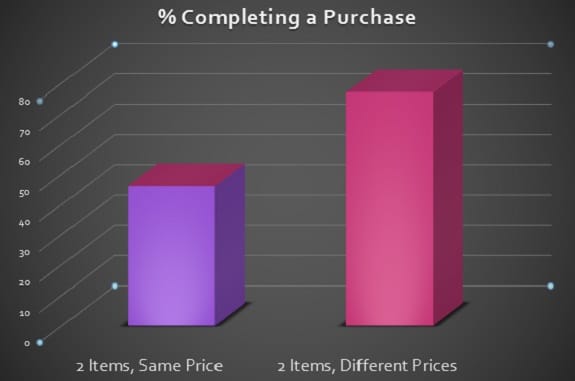
In the opposite case, when the packaging of chewing gum costs differently – 62 and 64 cents; more than 77% of consumers made a purchase.
This does not mean at all that the prices for the same t-shirt for its different colors should fluctuate. Not at all! It is essential to take into account the psychological factors and motives of purchases – if the same products have equal value, the buyer is more likely to leave your landing page.
2. Using the anchor effect (“anchors”)
How to guarantee to sell watches for $ 2000? Place them next to the watch for $ 40,000!
This bizarre tendency in customer behavior is explained by the existence of the binding effect or “anchoring effect.” A feature of the estimation of numerical values by a person. That made his decision based on the initially received information. That is why a $ 2,000 watch seems cheap next to a $ 40,000 chronometer.
If they are placed on a shelf along with Timex for $ 49, customers will perceive the product for $ 2000 as a purchase of a Premium class.
This method is very often used in restaurants. When opening a menu, the client, first of all, pays attention to the exclusive offer from the chef (usually the most expensive dish of the evening). In most cases, it is placed on a separate page or in the header (in the header, if this is a webpage).
Compared to the cost of a chef’s dish, $ 8 for croutons seems to be an acceptable amount.
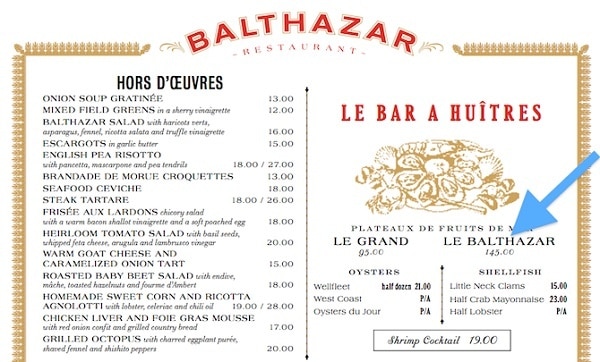
Exploring the significance of the “anchor effect” in the pricing process, Harvard Business School professors experimented. They evaluated the value of several homes for sale by owners. The booklets issued to the participants in the experiment had necessary information about nearby buildings. Some of them had an average cost, while the prices of others were intentionally inflated.
As a result, buyers and including real estate agents “got hooked.” They drew their conclusions right from fake high prices.
3. Secrets of Weber’s Law
According to the principle of Weber (sometimes Weber-Fechner), the difference between two sensations (stimuli) is directly proportional to the intensity of the stimulus. We perceive the ratio of this difference to the strength of the initial stimulus.
Weber’s law is often applied in the field of marketing. When it comes to pricing, the competent use of the principle allows you to increase product prices by about 10%. It doesn’t cause any suspicion among consumers and avoiding all kinds of complaints.
It must be borne in mind that a vast number of factors affect pricing, ending with derivatives – business reputation, brand loyalty ranging factors- supply and demand. Weber-Fechner law should be taken instead as a guide to testing product prices,q than as an iron pricing rule.
4. Reducing “pain of paying” in the sales process
According to studies by experts in neuroeconomics, the human brain is designed differently. It doesn’t let people stop spending money until there is a sensation of “pain of paying.”
Carnegie Mellon University conducted a scientific study. It showed several ways to reduce the number of such “pain points” in the shopping process. Here are some of the most original methods:
Reformulate the value proposition. It’s much easier for the client to evaluate the price-benefit ratio when buying a monthly subscription for $ 84 than is better than an annual one for $ 1000.
Use a complete set. Neuroeconomics expert George Lowenstein believes the Lexus LX is an excellent example of a successful package. It’s easier to assess the potential benefits of a single set of complementary goods (complementary goods). It’s better than to think about how cheaper it is to purchase high-quality leather chairs. Also, by ordering a navigation system at the same time can be a win.
Use the little things. According to Western wisdom, “The Devil is in the Little Things” – an online DVD store had shown some results. It changed the inscription on the subscription price from “Prepayment $ 5” to “Small prepayment $ 5” increased sales by 20%.
Appeal for utility or pleasure. For conservative customers, a marketing message about the usefulness of purchase is always more compelling: “General massage relieves back pain.” Buyers who are free from prejudice focus on the pleasure of consumption: “General massage will help relieve tension.”
Either free or paid. “Free” is a powerful word that works according to the principle of Dr. Cialdini, “click, buzzed.” Dan Ariely also spent a lot of attention to him in his book Predictable Irrationality.
Consider the example given by the professor. Amazon sales in France were much lower than average sales in other European countries. The problem was in the unfortunate 20 cents that were removed from the poor French for the delivery of goods. In other European countries, the service was free.
5. Test old classic methods
The non-round price policy ($ 8.99) is one of the oldest pricing methods, but is it useful in practice?
Relying on the study of the American journal Quantitative Marketing and Economics (Quantitative Marketing and Economics), of course, you need to answer yes. Prices ending with the number 9 could outperform lower prices for the same products.
When comparing prices for women’s clothing at $ 35 and $ 39, the study showed surprising data. When using the price with the number 9, sales were higher by 24%.
So that you are convinced of the power of the “nine.” For example, imagine that there is a specific product X worth $ 60. The seasonal discount on it is $ 15. The advertisement reads: “It was $ 60 — now only $ 45!” It would seem a great offer. But now compare this inscription with the following: “It was $ 60 – now only 49!”. Now, from the height of the flight of an independent expert, you will probably decide that the first is the best option. And you will be right because it saves more money. But believe me, you will almost without hesitation give preference to the second option.
6. Focus on the contrast “Spent time vs. Saving”
Why Miller Lite chose the slogan “It’s Miller Time!” (Time for Miller!)? We can confidently assume that a massive number of different options for the marketing message were tested. And from this point of view, the choice of this slogan seems at least unexpected. At first glance, it’s just reckless to use a tagline that does not present any potential benefits to the consumer. Why not focus on affordable prices?
Jennifer Aaker conducted a new study. A marketing professor at Stanford University cherishes pleasant memories. It’s not about how much money they saved when buying, but about the time they spent with this product.
“Consumer experience associated with a particular product contributes to the formation of a sense of personal commitment to a particular product. The reference to the time spent with the product forms a more favorable attitude of the client to the company and contributes to sales growth. ”
In an interview with Wharton Business School, Aaker notes that purchases tend to fall into two categories: “empirical” and “material.” Marketers must think through their slogans and messages very carefully. Because when buying a ticket for a symphony concert, the buyer benefits from hanging out. And when he buys designer jeans, the idea of the “money spent – prestige” relationship is inevitable.
7. Never compare prices for no good reason.
Stanford University did another study. In an unreasonable comparison among their prices with competitor prices, the use of such tactics can cause an unforeseen reaction of consumers.
You can lose customer confidence in the business by asking customers to compare your prices with those of a competitor directly. According to a lead researcher:
“The fact that you asked your customers to compare prices makes you suspect that you somehow deceived them.”
8. Use the power of context
Everyone knows the Budweiser beer brand. Its ownership has been disputed for more than 50 years by the Czech brewing company Budweiser Budvar and the American Anheuser-Busch. Can it be that in one place, Budweiser will cost more than in any other? Logic suggests no. But lovers of the third most popular drink in the world will say that where you buy is as important as what you buy.
A study by Vanderbilt University published in the New York Times Magazine shows consumers to study. Consumers were willing to pay more if they knew beer was provided by an upscale hotel rather than a seedy grocery store.
Economist Richard Thaler believes that in this case, the situation itself (context) played a role. The prestige of the hotel allowed to increase the price of beer with impunity.
It also explains why consumers pay more for a multimedia course than for the same information in the form of an e-book. You need to provide potential customers with subtle signals (engaging content, social proof, etc.) to justify your high prices.
9. Test different price levels
William Poundstone (author of Priceless): The Myth of Fair Value, argues that a lack of variety in product prices can significantly affect sales.
In her book, Pownstone assesses consumer behavior when choosing beer (yes, this is another study about beer :).
The buyers were provided with two options in the first experiment for the drink: ordinary and first-class. Accordingly, the prices were as follows:
Test 1:
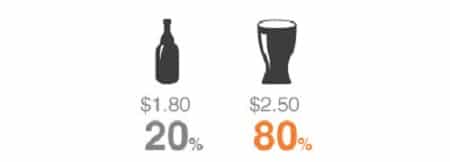
In this case, 4 out of 5 participants opted for the highest quality beer.
The second test was to add a third beer option for $ 1.60. It helped expand the target audience at the expense of those who were interested in cheaper beer.
Test 2:
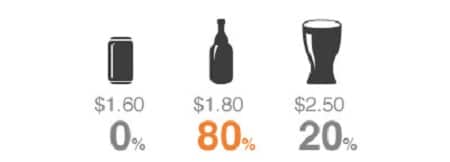
As you can see, cheap beer was utterly ignored by customers. Their attention was distributed between the two remaining options. And the outsider of the first test, beer for $ 1.80, became an unattainable leader.
But what happened when the cheap beer for $ 1.60 was replaced by the most expensive at $ 3.40:
Test 3:
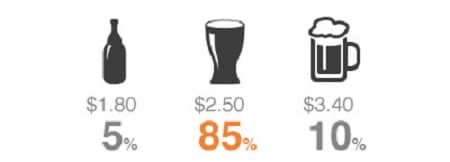
Fine! Beer for $ 2.50 is now preferred by 85% of buyers that ultimately turned out to be the most profitable option.
These examples demonstrate the need to test their price offers. Some consumers are focused on the prestige of goods, quality, and others on accessibility. If you want to please all these categories, the only way to find the best option is testing!
10. Prices should be straightforward!
And we would like to finish this post with the most primitive pricing theory you have ever encountered.
The results of one of the many studies on behavioral economics published in the Journal of Consumer Psychology suggest astonishing data. The prices with a large number of signs seem to consumers to be excessively high.
When customers were shown the following prices:
- · $ 1,499.00
- · $ 1,499
- · $ 1499
then the first two options were immediately rejected as too expensive.
This study may seem somewhat meaningless, but still, one worthwhile conclusion can be made. The price structure should be as simple as possible.
We hope that you have learned from this unique material something valuable for yourself and your business.
If you have any questions or you have your own opinion on the topic of this post, do not forget to share it with us in the comments below…

